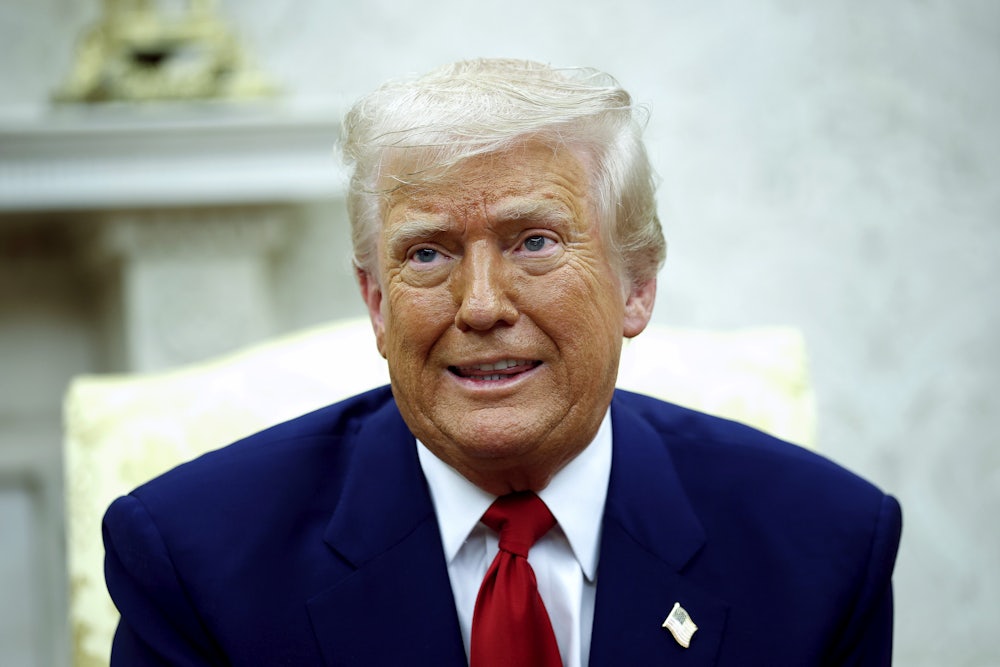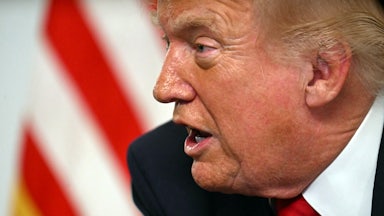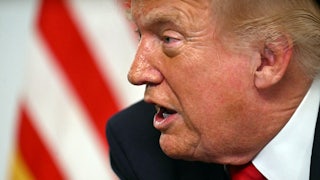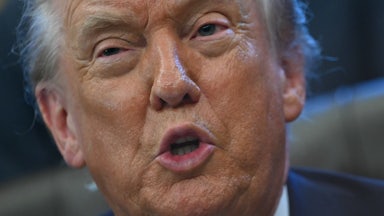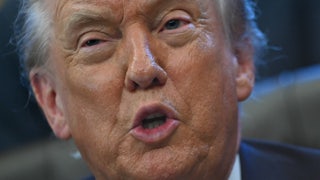President Trump’s top allies and advisers know that when the going gets tough, the way to keep Trump from flying entirely off the rails is to slather him with unctuous flattery. “Everybody in Washington, whether they want to admit it or not, knows that this president is right when it comes to tariffs,” White House press secretary Karoline Leavitt lied on Tuesday, plainly intending to calm the Audience of One, who has been raging lately about the domestic and global backlash to his tariff fiasco.
Now this approach to managing Trump has apparently spilled over into misleading him about public opinion on the tariffs as well. Politico reports that Trump’s inner circle “feels strongly that levying tariffs was a promise made to working-class voters, and that they’re delivering.”
The basis for this, relates Politico, is private polling that “shows the tariff strategy is playing well among working-class voters who agree with Trump that other nations have taken advantage of the U.S.”
But is it really true that working-class voters agree with Trump on this? Not according to a good deal of public polling. Indeed, public polls actually suggest that Trump’s tariffs threaten to alienate such voters—in a way that provides Democrats an opening to fracture the working-class coalition that elected Trump in 2024.
Trump has now temporarily paused some tariffs, but a universal 10 percent tariff is still in place, and he’s jacked up tariffs on China further, locking us in an intensifying trade war. In 90 days—or, who knows, nine—Trump could flip-flop yet again. The politics of this will get worse, including with working-class voters.
One of the most fine-grained polls on the topic is a recent national survey from Marquette Law School, a gold-standard poll. It finds that 51 percent of non-college-educated Americans (the standard definition of “working class”) say “imposing tariffs or fees” on products imported from other countries “hurts the economy,” while only 32 percent of them say this “helps the economy.”
Notably, the Marquette poll also breaks this down by race and education:
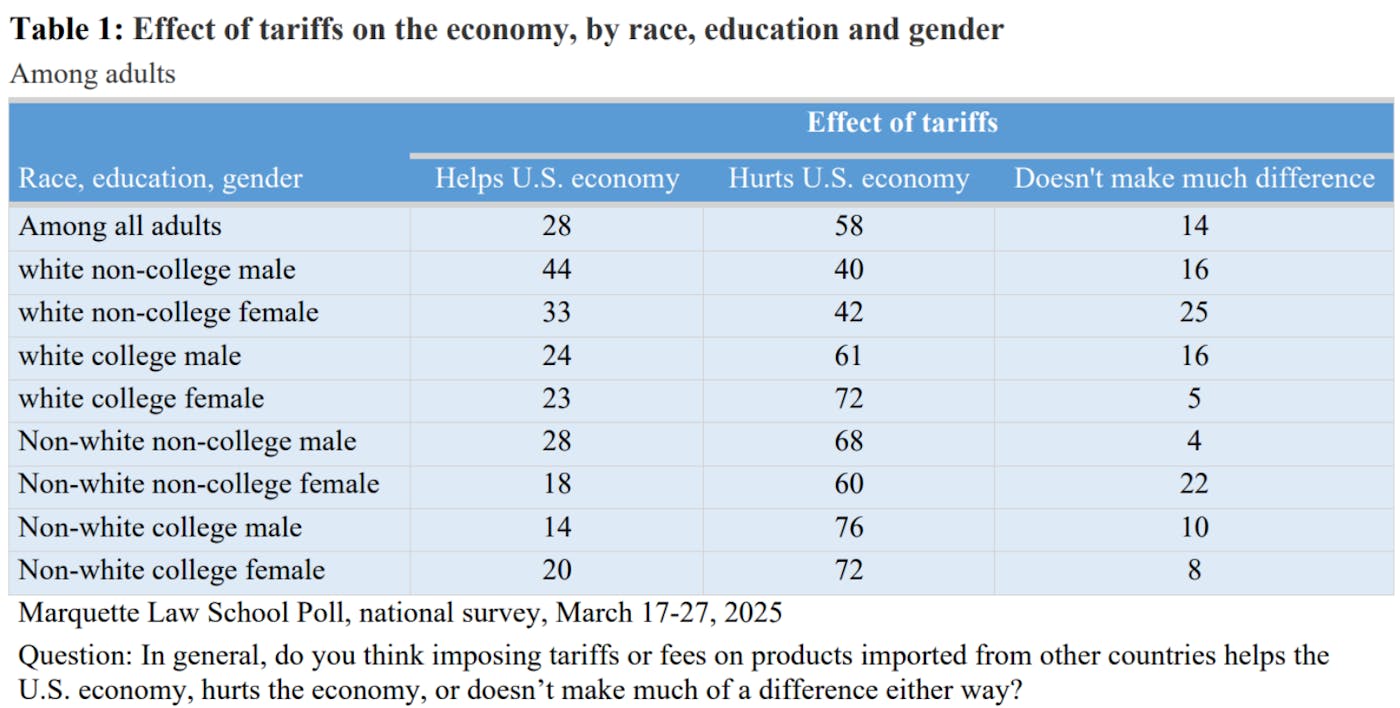
Of all these non-college categories, only non-college white men believe tariffs help the economy, and only by a bare plurality of 44 percent to 40 percent. Non-college white women say tariffs hurt the economy by 42–33. Non-college nonwhite men say this by 68–28, and non-college nonwhite women say this by 60–18.
So nonwhite, non-college voters are overwhelmingly skeptical of tariffs. This, plus skepticism among non-college white women and even surprisingly high opposition among non-college white men—the molten core of Trump’s base—is why majorities of non-college voters overall think tariffs will hurt, not help.
By the way, this also holds on income: Majorities of every income group earning less than $100,000 per year (and above, as it happens) say tariffs will hurt the economy.
That poll is from late March. But is there any reason to think all this has changed in Trump’s favor since he announced the tariffs? No. The specifics are now coming into sharper view. So is the domestic and global backlash.
And as Marquette Law School Poll director Charles Franklin points out, some congressional Republicans have now started breaking from Trump. “We’ve seen no evidence that non-college people are becoming more favorable to tariffs,” Franklin tells me. “All kinds of people—including non-college people—are likely to become more opposed to tariffs, especially as you see Republicans in Congress taking up that skepticism.”
The Marquette poll also finds that non-college Americans believe by 52 percent to 34 percent that Trump’s policies will increase inflation. Here again, only non-college white men believe Trump’s policies will decrease inflation, while non-college white women and especially non-college nonwhite Americans say his policies will increase it:

A recent CNN poll also shows a similar racial split among working-class voters. In that survey, non-college voters overall disapprove of Trump’s handling of tariffs by 59 percent to 41 percent. Among non-college white voters the split is 50–50. And according to CNN’s polling unit, among non-college nonwhite voters, it’s 71 percent disapproving versus only 28 percent approving.
There may be a structural explanation for these divides, says Richard Yeselson, a veteran labor analyst who has written perceptively about the nonwhite working class. Yeselson points out that as a general matter, working-class whites have tended to be more concentrated in heavy manufacturing and extractive industries, whereas working-class nonwhites often tend to have jobs in health care, service, retail, warehouse work, wholesale delivery trucking, and the like.
Many among the former might be inclined to think tariffs will protect their jobs (that’s actually not true, but put that aside for now). The latter, by contrast, might see their occupations as unlikely to gain from restrictions on trade, Yeselson notes.
“The nonwhite working class are disproportionately working in those industries where they perceive they’re not going to get a benefit,” Yeselson tells me. “If you’re working in an Amazon warehouse, Amazon is getting all these 50-inch televisions and iPhones from China. Those will not only be more expensive for consumers, but Amazon is already canceling some of these orders altogether. That’s bad news for port truck drivers and warehouse workers who are disproportionately nonwhite.”
It’s true that Trump’s most loyal voters among the white working class might think tariffs will protect them. But if his advisers are telling him this means working-class voters more broadly support them, then they may be operating from a nostalgic, outdated picture of the working class—one that is also likely seductive to Trump.
All of which may give Democrats an opening. Trump’s win was driven in part by his ability to win over low-propensity, nonwhite, working-class voters who were alienated by the cost of living crisis. So the tariff fallout could give Democrats a way to appeal to those voters again, especially if and when prices rise.
Why would any of this get better for Trump over time? If anything, the media scrutiny of his tariffs continues to intensify as the specifics come out and the true depths of incoherence and recklessness on display here are laid bare. The global uproar continues to mount as other nations announce reciprocal tariffs. National headlines continue to blare forth news of markets collapsing.
This is exactly the sort of atmosphere of crisis that has the capacity to pierce through people’s information silos. Well, with the exception of one person’s information silo, anyway: that of the Audience of One.
